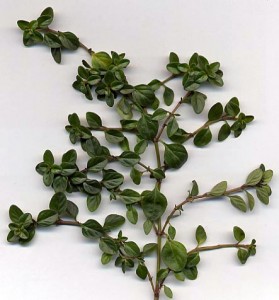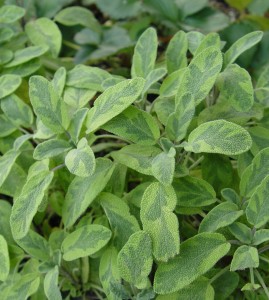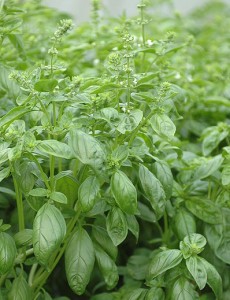Herbs and Health Benefits
Posted in Gardening Tips on May 13 2014, by Sonia Uyterhoeven
Sonia Uyterhoeven is the NYBG’s Gardener for Public Education.

I always think of herbs in terms of their flavor blast—they transform even the most mundane dinners into gourmet meals. Last summer while our Wild Medicine exhibition was taking place, I took a step further and began exploring their curative properties. I spent that summer investigating eclectic herbal shops in NYC, perusing collections of neatly alphabetized glass jars filled with every dried herb and spice imaginable. My primary tools of investigation were my nose and taste buds, and most of the herbs became teas once I got them home.
I learned that thyme settles the stomach and is a good remedy for coughs; marjoram can aid against sinking moods and benefit a good night’s sleep; peppermint will aid digestion and fight headaches and stuffy noses; sage helps against sore throats and gums; and tarragon is good for toothaches. Some say the ever-popular basil can even bring relief to arthritis sufferers.
This year I delved a little deeper into herbal health benefits. I began my investigation with thyme, since I was familiar with its active ingredient—thymol—not in a medicinal context, but as an effective ingredient in most pest repellants (deer and rabbits).
Thyme has been used throughout history as a remedy for respiratory problems such as coughs, bronchitis, and lung congestion. And thymol, the aforementioned active ingredient, is also responsible for the plant’s wonderful scent. Thyme further contains several flavonoids, including apigenin and naringenin.

When discussing thyme, all the modern health buzzwords seem to be covered. Thymol increases omega-3 fatty acids and is good for supporting a healthy brain, kidney, and heart. The flavonoids boast strong antioxidant and anti-inflammatory properties.
In addition to this, the volatile oils in thyme act as antimicrobials against several types of bacteria and fungi. This is not new information, of course—for centuries, herbs and spices have been used to preserve foods. In the past decade, studies are now showing that thyme and basil may even be capable of defending against microbial contamination.
With this information in hand, adding fresh thyme and basil to your favorite vinaigrette recipe or directly onto your salad suddenly sounds like a great idea. For uncooked foods, this will help fight the bacteria that can sometimes contaminate them. Thyme also fares well in terms of its nutritional value—it is high in Vitamin C and contains Vitamin A, iron, copper, and manganese.
Due to its antiseptic properties, thymol is a common ingredient in many commercially available mouthwashes. It is also an active ingredient in many hand sanitizers. For the natural healers out there, you can make a cup of thyme tea to ward off coughs and sore throats. Just add 2 tablespoons of fresh thyme or 1 teaspoon of dried thyme per cup of boiling water. Infuse for 10 minutes, add honey or lemon for flavor, or go for something a bit more spicy with grated ginger, cayenne pepper, or turmeric.
Thyme isn’t the only herbal superstar on the healing front. The ubiquitous basil leaf has many redeeming qualities when it comes to health, including compounds that offer antioxidant, antiviral, and antibiotic properties.

Basil has anti-inflammatory properties as well, and has been used by individuals suffering from conditions such as rheumatoid arthritis. In terms of its nutritional value, basil is high in Vitamin K, manganese, and Vitamin A and C, and also contains calcium, iron, folate (i.e. folic acid), and magnesium.
Oregano provides more of the same goodness. It is high in Vitamin K, manganese, iron, fiber, and calcium. It is used medicinally to help treat gastrointestinal problems and respiratory ailments. It contains thymol as well, so it has many of the same properties as thyme. It also contains rosmarinic acid which provides benefits for asthma sufferers. Along with mint, oregano works to ease constricted sinus passages and helps relieve symptoms of congestion. Truth be told, herbs are no longer regarded as additional garnish—many of them provide a range of potential health benefits that make them worth including in any healthy diet.
Thyme and basil images courtesy of Wikimedia Commons.


Sonia, thank you for such a detailed article about these common kitchen herbs. I have been researching a bit on the Lamiaceae family and this is a great resource for a medicinal take on some of its members. I hope you can continue writing more about other medicinal herbs that you come across in the future.